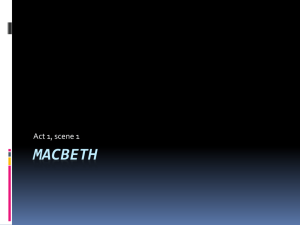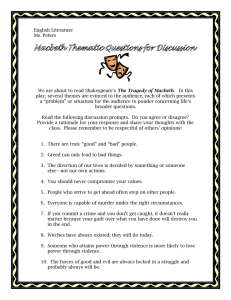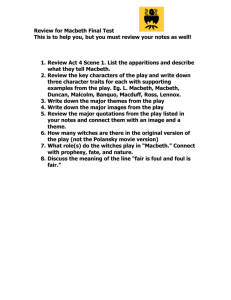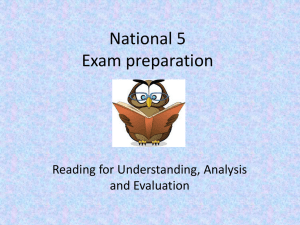Universidade Federal de Santa Catarina
advertisement
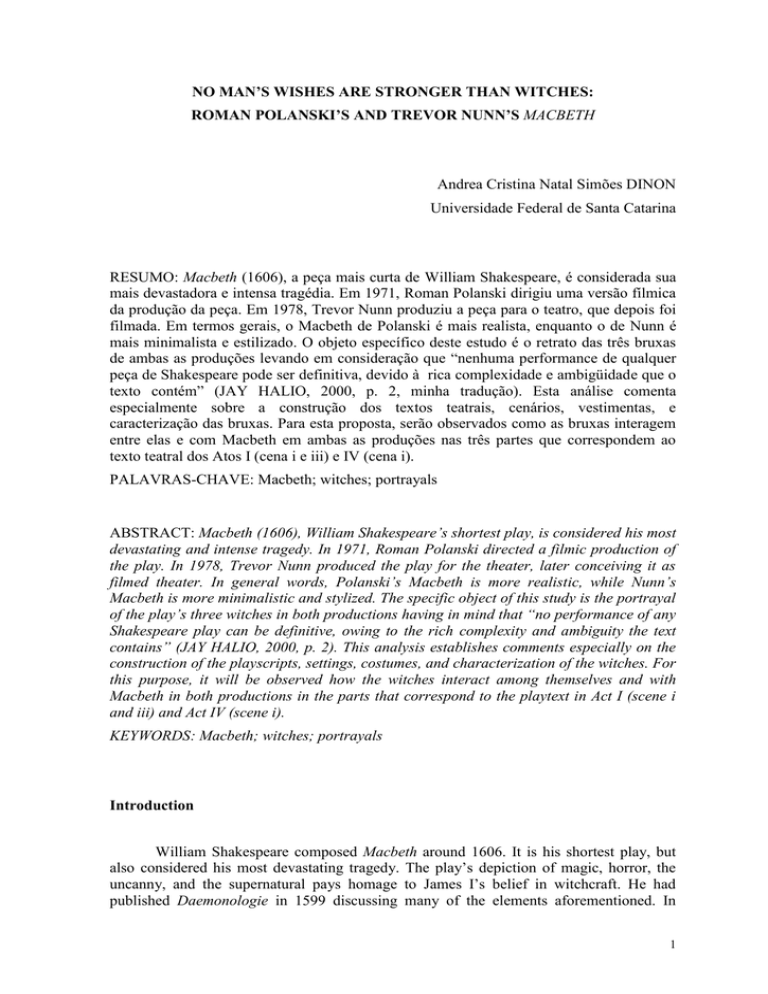
NO MAN’S WISHES ARE STRONGER THAN WITCHES: ROMAN POLANSKI’S AND TREVOR NUNN’S MACBETH Andrea Cristina Natal Simões DINON Universidade Federal de Santa Catarina RESUMO: Macbeth (1606), a peça mais curta de William Shakespeare, é considerada sua mais devastadora e intensa tragédia. Em 1971, Roman Polanski dirigiu uma versão fílmica da produção da peça. Em 1978, Trevor Nunn produziu a peça para o teatro, que depois foi filmada. Em termos gerais, o Macbeth de Polanski é mais realista, enquanto o de Nunn é mais minimalista e estilizado. O objeto específico deste estudo é o retrato das três bruxas de ambas as produções levando em consideração que “nenhuma performance de qualquer peça de Shakespeare pode ser definitiva, devido à rica complexidade e ambigüidade que o texto contém” (JAY HALIO, 2000, p. 2, minha tradução). Esta análise comenta especialmente sobre a construção dos textos teatrais, cenários, vestimentas, e caracterização das bruxas. Para esta proposta, serão observados como as bruxas interagem entre elas e com Macbeth em ambas as produções nas três partes que correspondem ao texto teatral dos Atos I (cena i e iii) e IV (cena i). PALAVRAS-CHAVE: Macbeth; witches; portrayals ABSTRACT: Macbeth (1606), William Shakespeare’s shortest play, is considered his most devastating and intense tragedy. In 1971, Roman Polanski directed a filmic production of the play. In 1978, Trevor Nunn produced the play for the theater, later conceiving it as filmed theater. In general words, Polanski’s Macbeth is more realistic, while Nunn’s Macbeth is more minimalistic and stylized. The specific object of this study is the portrayal of the play’s three witches in both productions having in mind that “no performance of any Shakespeare play can be definitive, owing to the rich complexity and ambiguity the text contains” (JAY HALIO, 2000, p. 2). This analysis establishes comments especially on the construction of the playscripts, settings, costumes, and characterization of the witches. For this purpose, it will be observed how the witches interact among themselves and with Macbeth in both productions in the parts that correspond to the playtext in Act I (scene i and iii) and Act IV (scene i). KEYWORDS: Macbeth; witches; portrayals Introduction William Shakespeare composed Macbeth around 1606. It is his shortest play, but also considered his most devastating tragedy. The play’s depiction of magic, horror, the uncanny, and the supernatural pays homage to James I’s belief in witchcraft. He had published Daemonologie in 1599 discussing many of the elements aforementioned. In 1 1971, the Polish director, Roman Polanski directed the film Macbeth starring Jon Finch in the title role. In 1978, the English director, Trevor Nunn, produced the play Macbeth, and, then, conceived it for television, as filmed theater. While Polanski’s Macbeth is, in brief words, more realistic, Nunn’s Macbeth is more minimalistic and stylized, characteristics which will be discussed throughout this paper. The objective of study here is the portrayal of the witches in both productions, aiming at their similarities and differences, and having in mind that “no performance of any Shakespeare play can be definitive, owing to the rich complexity and ambiguity the text contains” (HALIO, 2000, p. 2). This analysis was only possible due to the media in which these productions were made available: cinema and filmed theater, respectively. James C. Bulman points out that these media have an advantage over theater because “film and video allow us repeated viewings of a single performance, they encourage us to assimilate that performance to the condition of a literary text – a stable artifact rather than a contingent, ephemeral experience” (BULMAN, 1996, p. 2). The possibility to watch and re-watch these productions as well as pausing them whenever I wanted to take notes were the facts that made this study possible. This is the reason why I am grateful to the fact that Nunn’s RSC’s production of Macbeth was video recorded for TV. Having said this, I will carry on the analysis of the performances offering comments especially on the construction of the playtext, settings, costumes, and characterization. Considering the text, it is important to remember that “neither Shakespeare nor his fellows regarded his scripts as beyond or in any sense untouchable” (HALIO, p. 9). The key point regarding the construction of text here will be pointing out which lines were cut or inverted (in terms of character and also the order of presentation in the performance), looking for a possible explanation for that. In relation to set design, as pointed by Halio, “there are many ways to design sets and costumes for a Shakespeare play and no single ‘right’ way. But some ways may be more appropriate and effective than others” (HALIO, p. 22), and studying these elements of the performances will be my concern as well. In terms of the characters, I will observe how they say their lines (jokingly, quietly, angrily, nervously, etc), and I will pay close attention to “not just a matter of an actor’s finding a way into a role alone, but the interaction of two or more actors working closely together to establish a relationship that their roles demand” (HALIO, p. 36). For this purpose, I will observe especially how the witches interact among themselves, and with Macbeth corresponding to the playtext in Act 1 (scene 1 and scene 3) and Act 4 (scene 1). Act 1 (scene 1) – The witches come forward On the one hand, “Polanski should favor the somber part of Macbeth” (GROSSVOGEL, 1972, p. 49) with his realistic and macabre scenes; while, on the other hand, the conception of Nunn’s Macbeth was “an enactment of a ritual, a performance that partook of exorcism and Satanism” (MULLIN. 1987, p. 355). Polanski achieved his aim through lots of bloody and violent scenes, while Nunn was more concerned with an 2 intimate environment that he constructed by the use of an on-stage circle around which all characters were placed. Polanski’s production starts with a long shot of a beach. It is daybreak. Sea-gulls are heard and seen. Someone enters the screen from right to left holding a stick. From now on the camera will close-up on different parts of the scene. This person draws a circle on the sand, and two women approach the circle to dig it fiercely. So far it is impossible to see their faces since two of them have their heads partially covered, and the third one has her blond, loosen hair untidy. One of them takes a piece of rope from a sack. The rope is tied as if it was or would be used to hang someone. She places it in the hole. The blond woman goes to a cart, grabs something else, and brings it to the other two. At this moment there is a medium shot of the three women, and we start to realize that they are witches for their ugly appearance (the faces of two of them are distorted by make-up) and for the ritual that they are carrying on. The witch on the right – who apparently has a physical mal-formation of the eyes, due to make-up, of course – unpacks what has been brought by the blond witch. Wrapped by the cloth is a human hand, which the older woman places in the hole together with a dagger, placing it as if the hand was holding it. They keep placing other things in the hole and, finally, cover it with sand. The older witch opens a bottle and drops blood over the sand. Until now they had performed everything silently, and now they say together: “Fair is foul, and foul is fair, / Hover through the fog and filthy air” (I. i. 11-12), which is the motto in this play, being repeated by different characters in different situations. Having said this, I need to point that lines 1 to 10 from this act were omitted so far, probably because Polanski intended to construct the film’s opening atmosphere in a gloomier way, through the images, instead of the lines, which I considered perfectly valid. After saying their first line in the film, the witches spit together on the ritual place three times, as a way to mark their territory and complete the ceremonial. Then the blond witch helps the older one to stand up. And only at this moment, lines 1-10 are said by the two older witches, leaving the youngest to organize everything and pack the cart for them to leave, as if she was not experienced enough in witchcraft to have lines of her own. The scene ends with them departing with their back to the camera, in a long shot of the beach. The blond and youngest witch pulls the cart, while also aiding the older witch. They walk in the opposite direction of the camera and mist starts to evolve to give place to the film’s title. The scene takes almost four minutes. 3 Image 1: Left to right: Second witch (Elsie Taylor), Third witch (Noelle Rimmington) and First witch (Maise Macfarquhar) Nunn’s production starts with a crane shot of a circle into which the actors come forward. A religious song is playing while the camera makes a close up of each one of them. The set is basically designed and the contrast of light and dark places in it helps the entrance and exit of the characters. The last character to be filmed in the close-up is one of the witches. Then, the camera shifts focus to allow the approaching of the other witch. They do not speak to each other, but they touch themselves as a form of support. The younger witch seems to have been crying, very unbalanced, and looking for the support of her friend. There is another long shot of the entire circle from the side, which allows a third witch to approach the center of the circle to sit on the ground with the other two. She is very calm and sure of herself. They seem to be casting a spell in the center of the circle. Then, there is a shot of Macbeth (Ian McKellen) being greeted by Duncan (Griffith Jones). We listen to the witches moaning and making strange sounds while Duncan prays, which reinforces the conception of the play: religion vs. witchcraft. There is another shot of the witches, now shouting as if they had been suffering from Duncan’s prayers. The younger witch is dribbling as if she were in a trance. There is another close-up of Duncan praying, with the witches screaming even louder. Then we see lightning, which illuminates the witches’ faces, and hear thunder. Finally the witches seem happy, as if their plans had succeeded. The older witch speaks and the younger witch answers her. It is the middle-aged witch who says Macbeth’s name by completing the younger witch’s line. The two other witches repeat Macbeth’s name in surprise. They say their last lines (not respecting the assigned roles in the playtext) standing, then, they leave. The scene takes approximately four minutes. Image 2: Left to right – Third witch: Susan Dury (also Lady Macduff), second witch: Judith Harte (also Gentlewoman) and first witch: Marie Kean. 4 Both productions started with the witches conducting a ritual. Polanski opted for foreshadowing elements of the battleground that would take place in the film’s next scene. In Polanski’s production, the circle appears as it is drawn by one of the witches on the sand while the circle in Nunn’s production appears around the witches (the demarcation can be seen in the photograph). In both productions, the younger witch seems to have less experience in witchcraft than the other two, which may be an explanation why they ‘steal’ most of her lines from the playtext, and she is regarded as an aid to the older (in Polanski’s) or as a mad woman (in Nunn’s). The older witch in both productions tends to be the calmer and more concentrated, as if she is the one who knows what has to be done. In both productions the witches are dressed in rags, with their hair untidy, but only Polanski opted for a heavy and creepy make-up. Act 1 (scene 3) – The three prophecies In Polanski’s production of this scene Macbeth (Jon Finch) and Banquo (Martin Shaw) have come from the battlefield on horseback. Everything the witches have prepared in the ritual occurred in the previous scenes (killing and hanging). A creepy song is in the background and it is raining and windy. The men try to protect themselves from the rain under a big rock. They observe a group of people passing nearby while we hear that the play’s motto is on Macbeth’s mind. Voices as if in a song are heard in a distance, and the horses get agitated. Banquo goes to check it and Macbeth follows him. Banquo sees two of the witches under an improvised tent and tries to talk to them. These are the first lines spoken in this scene, which means that the entire conversation (lines 1-37) from the beginning of this scene is cut (but I think it is acceptable, since the witches will have their opportunity to awe the spectators in Act 4, scene 1). It is still rainy and windy. The older witch is putting something on the younger witch’s back (again she is being taken care of). The first witch hails Macbeth. The second comes from off-screen (a cave? their residence?) and hails Macbeth too. The old witch tells him the first prophecy, the second witch tells him the second, and then the first witch tells him the third prophecy (‘stealing’ again the lines of the younger witch). The younger witch helps the first witch to stand up, and they start leaving the scene. Banquo asks them, in a pleasant tone, to talk to him. The witches have their back turned to them, showing he is not important to them, and we hear them saying their prophecies regarding his lineage. Banquo seems amused but Macbeth is frightened. Maybe that is why he is the one who gets off the horse and goes after them asking for explanation about the prophecies. The younger witch groans and raises her skirt for him in a disrespectful way, by showing she does not care about his worries. She follows the other two witches downstairs and slams a door, leaving Macbeth behind. They are said to have vanished into the air, but this is just metaphorical in this production. This scene takes approximately three minutes. 5 In Nunn’s production, this scene takes approximately four minutes; the first witch is alone on the foreground staring off-screen. The second and third witches come from the background supporting each other. They occupy their space in the scene almost as if they were standing in line, with the first witch on the foreground, the second on the middleground and the third on the background. The first witch does not look at the other witches. She starts putting needles in a voodoo doll while saying “I’ll do, I’ll do” (1. 1. 10) in a decisive way. At this moment the third witch in the background seems to be staring at nothing as if she is again in trance, while the second witch is doing something with her clothes, minding her own business. Thunder is heard. The third witch is dribbling again. The second witch announces the coming of Macbeth, as if she was reading the third witch’s mind in trance (since she is the one who says this line in the playtext). They approach and say lines 32-37 together before the entering of Macbeth and Banquo. Witchcraft seems to have drained the youngest witch’s entire energy since she faints on the first witch’s arm. Macbeth and Banquo run into the witches in the set and are surprised to see them. Banquo says the line about their beards (line 46), which always makes me want to laugh when seeing this scene, because the next shot is a close-up of each of the older witches and they have a subtle mustache. At these close-ups they say the prophecies (and, finally, the third witch says something important). While Banquo is intimidating the witches to make them speak prophecies for him as well, Macbeth turns his back to the camera. Banquo stands in front of the three witches. He is tall in the shot and imposes his voice and presence upon them. The witches are shown together and they bow saying ‘hail’ as if obeying him. The witches give their prophecies, one at a time. The camera makes a close-up on one of the witches and then on Banquo, and repeats it at the other two witches for the other two prophecies. As the witches stand up, Macbeth asks them to stay and threatens them with his dagger. He points it to the first witch, then to the second, then to the third. He goes back to the second witch and she has vanished into the air (with no special effect, she just went off-screen). He looks for the first witch and for the third one, and when he goes back to the first witch, she has disappeared too, and the same thing happens to the third witch. When comparing the two productions I like that Polanski opted for showing Macbeth appearing first in the scene, because in comparison to Nunn’s production, the first has more impact. No one (except those who know the story, of course) expects him to meet the witches while with Nunn we do not get so surprised to see Macbeth interrupting the witches meeting. My favorite elements of this scene in Nunn’s production are the use of the voodoo doll and the vanishing into the air sequence, which were aspects that could have been (more deeply) explored by Polanski as well. In Polanski’s production only Macbeth seems to be taking the witches seriously and the witches correspond only to him while in Nunn’s production both Banquo and Macbeth threaten the witches and get frightened by them. Act 4 (scene 1) – Are you crazy, man? Why did you look for them again? 6 In Polanski’s production, it is again Macbeth who first appears at the scene, since he is going to look for the witches. A creepy song sets the mood of the scene. Macbeth arrives at the same place of the previously analyzed scene, listens to noises, songs and mourning. Macbeth approaches the witches’ cave and is grabbed by another witch who pulls him inside. Macbeth gets inside and sees a group of more than twenty white naked witches around a cauldron. According to Dolores A. Aguero (2009) “the nudity in Polanski’s film is almost as frequently discussed as its violence. However, more than being exploitative, it can be used to distinguish between dominators and those dominated” (p. 185). In this case, even though the witches are women, and are naked, I cannot see them as dominated in relation to Macbeth, since it is him who is in despair and depends on their favors and prophecies, therefore, I believe he is being dominated when he gets there. Image 3 The older witch, who seems to have no eyes due to make-up, is the one who “sees” Macbeth coming when saying “By the pricking of my thumbs / Something wicked this way comes” (lines 44-45). All of the witches laugh, probably because they can see that Macbeth is already there. Macbeth says his lines angrily, as if he were powerful enough to make them obey him (which I do not think he was). Witches say lines 10 and 11 together and one by one, they drop frog, blood and other elements into the cauldron while saying some of the playtext’ lines. Macbeth looks terrified but still demands them to help him. One of the witches grabs a chalice. They put the potion they were preparing in the cauldron in the chalice, and they give it to Macbeth. Some of the potion gets dropped on the way, and when it reaches Macbeth, he drinks it on his own (while letting most of it spill out, since it must have been quite ‘tasty’ due to the ingredients). Macbeth is in the foreground of the scene, on a higher level in relation to the witches, which now may represent he is the dominator, since he got what he wanted (them to obey him), but soon he will drop the chalice and fall into the witches’ arms. They help him to get to the cauldron, where he starts to have visions (a brilliant scene in this movie, although not the object of study here). Even though in the playtext the witches still remain with Macbeth during the apparitions, in Polanski’s production we are not able to tell up to which point they are still with him. We just know that he was left alone when he wakes up, 7 the cauldron is tossed aside, the cave is empty, and he curses the witches for being gone (Yes, man! They do what they want to do!). The witches’ Sabbath, together with Macbeth’s visions last approximately seven minutes. In Nunn’s production, as opposed to Polanski’s, just like the pattern established in the previously compared scenes, the witches appear in the scene before Macbeth. We listen to thunder and see a close-up of each of the witches. Even though it is the third witch who seems again to be in trance, it looks like the thunder is talking to the first witch and she answers to it with her line. The third witch does not say her complete line, which is complemented by the two other witches’ “’tis time, ’tis time” (3). The three witches sit together on the floor around something that was supposed to be a cauldron (but which is not so convincing) and two candles. We see a triangle of the three witches with the first witch on a higher level (almost standing) if compared to the third witch (almost lying on the floor). The first and third witches sing while the second witch continues to prepare the potion. The third witch is always looking at the first witch as if she were complicitly trying to learn from her. And surprisingly, she is the one who announces the coming of something wicked. Macbeth comes from the background and conjures the witches to help him, but they are not worrying about him. He comes and gathers them, remaining on the same level of the first witch surrendering to witchcraft. Macbeth looks at them when speaking, though they do not look much at him, especially the first witch, who definitely does not look at Macbeth in the eyes (not in terms of submission or fear, but in terms of superiority). When Macbeth says he wants to participate with them, the first witch stands up, takes off his coat/shirt. She makes him kneel, and then the third witch passes a sort of dark ink on his back and forehead drawing two crosses (I thought crosses where just for religious purposes, not for witchcraft). The second witch serves him the potion. The three witches are standing dominantly over him, and they say some lines, while forcing him to drink the potion. Image 4 8 Macbeth spits a bit of the potion and falls on the floor in trance, surrounded by the three witches. The lines of the apparitions are said by the witches themselves while Macbeth surrenders in the first witch’s arms. Some more tokens, as well as candles are used to frighten Macbeth, who looks really horrified with the visions that we cannot see. While they say “show his eyes” (line 110) the witches are in fact covering Macbeth’s eyes. We are left imagining what he is seeing while the witches leave the setting one by one blowing their candles out. Macbeth is left alone in the scene with the objects of witchcraft until he is met by Lennox. This scene lasts approximately eight minutes. What I particularly like when comparing these two productions is to see that again the pattern of who is in scene first (the witches or Macbeth), is repeated. Polanski tries to surprise the audience with the meetings while Nunn seems to prepare the audience for them. The pattern of dominance is also different in the two productions, and I have to confess that in comparison to Nunn’s production, Polanski’s witches are totally dominated by Macbeth. When considering the characteristics of these productions, I have to say that each one has some of my favorite moments, leaving me now with Macbeth’s visions from Polanski’s in a state of craving for more analysis (maybe I should conjure the witches to let me do so during my vacation). The scene with Nunn’s witches ‘vanishing into thin air’ is definitely my favorite, and could not have had the same effect if done on stage for a theater audience, instead of with cameras for a filmed theater (see, each media definitely has its advantages). Finally, the last scene of Polanski’s movie (with Donalbain looking for the witches) is also priceless. Referências AGUERO, Dolores A. ‘Strange Images of Death’: Violence and the Uncanny in Five Productions of Macbeth. PhD dissertation. Florianópolis: UFSC, 2009. BULMAN, James C. “Introduction: Shakespeare and Performance Theory”. In: Shakespeare, Theory and Performance. London and New York: Routledge, 1996, pp. 111. GROSSVOGEL, David I. “When the Stain Won’t Wash: Polanski’s Macbeth”. In: Diacritics, Vol. 02, No. 02 (Summer, 1972), pp. 46-51. <http://www.jstor.org/stable/pdfplus/2870509.pdf> HALIO, Jay L. Understanding Shakespeare’s Plays in Performance. Houston: Scrivenery Press, 2000. MULLIN, Michael. “Stage and Screen: The Trevor Nunn ‘Macbeth’”. In: Shakespeare Quarterly, Vol. 38, No. 03 (Autumn, 1987), pp. 350-359. <http://www.jstor.org/stable/pdfplus/2870509.pdf> NUNN, Trevor, dir. Macbeth. England, 1978. Royal Shakespeare Company. 146 min. 9 POLANSKI, Roman, dir. Macbeth. England, 1971. Playboy Productions, Columbia Pictures. 140 min. 10
